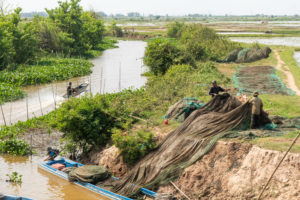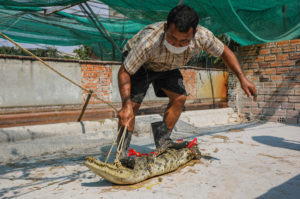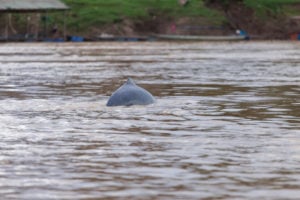For more than 15 years, Chhoeun Hoeum has been plying the waters of Veal Samnab lake. In recent years, his catch – and income – has grown smaller, falling alongside the water levels of the lake system.
Locals say that the lake, which is just across the Mekong River from Phnom Penh, was once filled with water even in the dry season, providing fish for locals and even a route for ferries that could transport hundreds of people. Veal Samnab has long been known as one of Cambodia’s largest lakes, covering more than 1,000 hectares.
“[Now] there are less and less fish,” Hoeum laments, dragging an empty net out of the shallow water of a stream that feeds into Veal Samnab. “Before we could fish all year long. We could get fish from the time the water was going up to the time the water went down… But now [it’s February] and the water has already dried up.”

When reporters for The Third Pole visited the lake earlier this year, large portions of it were completely dry. The exposed lakebed was firm enough to walk on, and villagers had divided it up to grow lotus and rice. Some had even fenced off their plots in a bid to assert ownership.
The jostling for land where Veal Samnab’s waters once were is a stark example of broader changes happening along the Mekong.
A ream of factors, such as overfishing, climate change, upstream dams and intensive regional development have long affected this region.
The worsening health of the Mekong ecosystem will affect the welfare of the roughly 70 million people who live along the river’s banks. The impacts of environmental changes are felt most visibly by local communities such as those around Veal Samnab, and others who make their living in the countless lakes, ponds and wetlands on the vast floodplain of the Mekong.
The ‘recipe’ for life in the Mekong wetlands
As Veal Samnab dries, Hoeum’s local waters are becoming more barren.
“Before, I could get 400 to 500 kilograms [of fish] per night,” Hoeum says, adding that those good nights were still possible as recently as 2019. “But now I only get about 50 kilos per night, and these are small fish for fish food.”
Though fishers can cast their nets during both the night and day, Hoeum said certain species of fish are more easily caught at night, when he believes they’re drawn to the moonlight.
He and other locals who spoke with The Third Pole said that Veal Samnab is shrinking with each passing year. The Mekong is gradually failing to replenish the lake, compounded recently by a drought in the Mekong catchment area between 2019 and 2021.
As fish become scarce and water levels fail to reach their historic depths, some villagers along Veal Samnab have stopped tending aquatic lotus in the lakebed in favour of hardier rice.
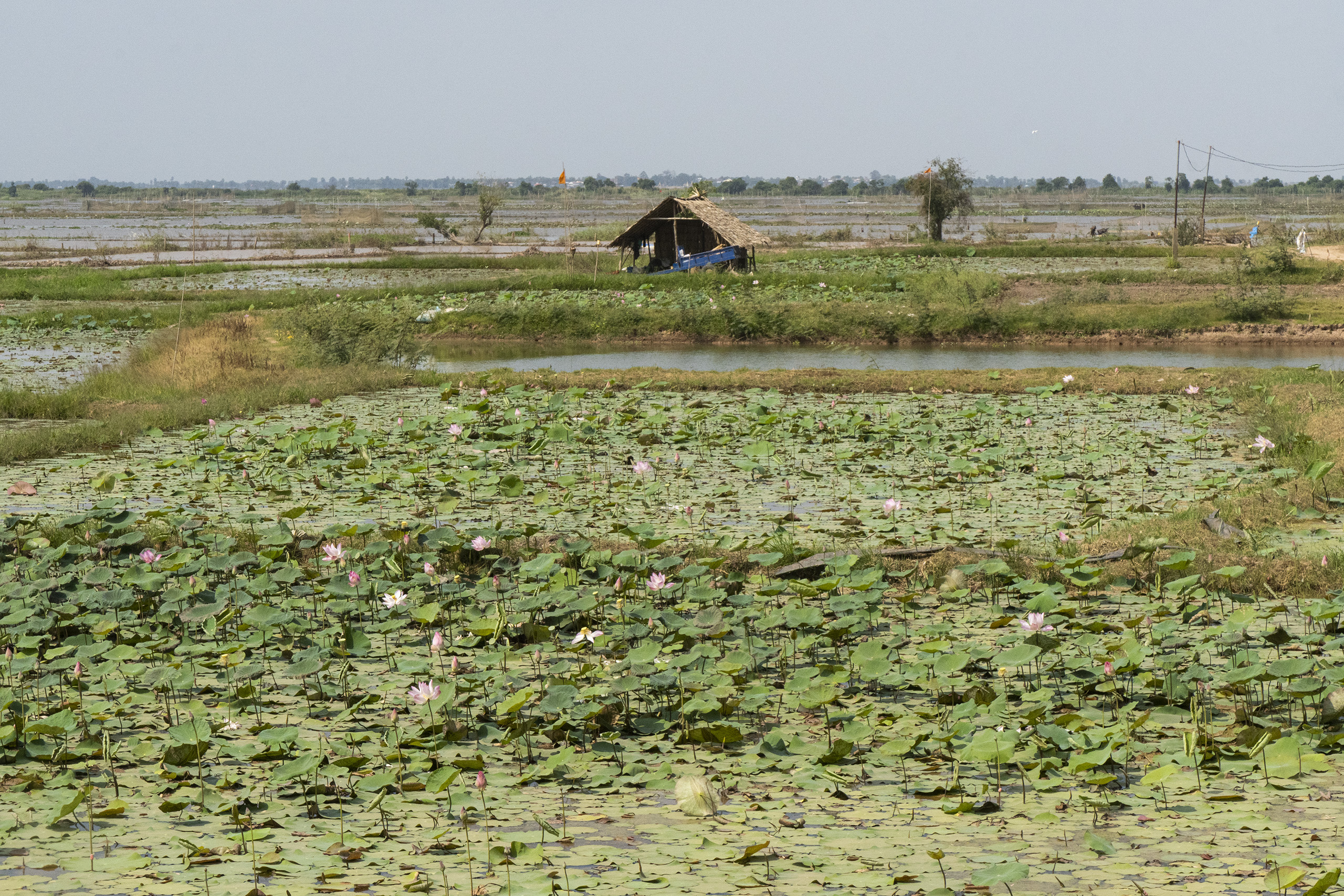
Elsewhere in the Phnom Penh metro area, local developers increasingly eye such shrinking waterways for construction. Bit by bit, people are filling in ponds, lakes and wetlands in a trend of mass-scale reclamation transforming the floodplain.
Last year, Veal Samnab was included as part of a larger reclassification of land to make it eligible for private ownership. A developer promptly asked the government if it could purchase the lake to drain it and build a residential and commercial project instead.
For now, state ministers have rejected such plans, saying they’d prefer to restore the lake to serve as a natural reservoir.
It remains to be seen what will become of those efforts.
Speaking broadly, Marc Goichot, the Asia Pacific freshwater lead at the World Wildlife Fund (WWF), says the increasing reclamation of the floodplain marks a profound change for Cambodia.
“From a socioeconomic perspective, Cambodia is a floodplain civilisation – the Khmer are people who lived on the natural levees and based their agriculture on the flooding,” Goichot says. “If you destroy the floodplains, you’re killing the golden hen that historically has fed the people.”
Goichot says the Mekong’s flood cycle plays a key role in replenishing groundwater in the soil along the plain. He explains that moisture supports other bodies of water, such as Veal Samnab, while the percolation of water through the earth contributes to regional aquifers.
“In the dry season, when it’s not raining, there’s still water in the river – that’s the water that the soil is giving back, so if you effectively recharge the soil with flooding, that will affect the hydrology,” Goichot says. When that “recharge” doesn’t come, he adds, the land becomes parched. “It’s a key explanation of why the dry seasons are getting drier,” he says.

Brian Eyler, the Southeast Asia programme director for the Stimson Center, a US-based think tank, describes the sheer productivity of the wider Mekong floodplain as being dependent on “an annual recipe” of water, fish and plenty of organic material.
“Basically, the floods take the bushes and leaves and all this stuff that was sitting on the riverbank during the dry season, and bring it off into the floodplain. That mix comes together to create an explosion of fisheries, of life,” Eyler says.
But none of that is guaranteed, he adds, and the changes along the Mekong basin have directly impacted the basic ingredients of the “recipe”.
“If you take one of those components out, the explosion of life isn’t going to happen. Unfortunately, in the last few years, each of those components has been reduced or removed.”
Visible shift at Veal Samnab
Back along the shores of Veal Samnab, local people keep recipes of their own. Many here have traditionally made their living from the cottage industry of smoking fish filets to sell in the capital and elsewhere across Cambodia.
Meas Sineth, 32, is among those who make a living from smoking fish. She tells The Third Pole that she has witnessed several key changes to the lake. When she was younger, Sineth recalls, the lake was consistently large enough that travellers needed a ferry to cross it, rather than just make their way along its edge.
“There’s no more ferry, as it’s very dried up now,” she says.
However, the loss of the local ferry pales in comparison with the reduced fishing industry. “When there’s a lot of water, there’s a lot of fish. They were spreading and breeding everywhere,” Sineth muses. “Now there’s no fish left to catch, so [we] buy all the fish from other people [elsewhere].”
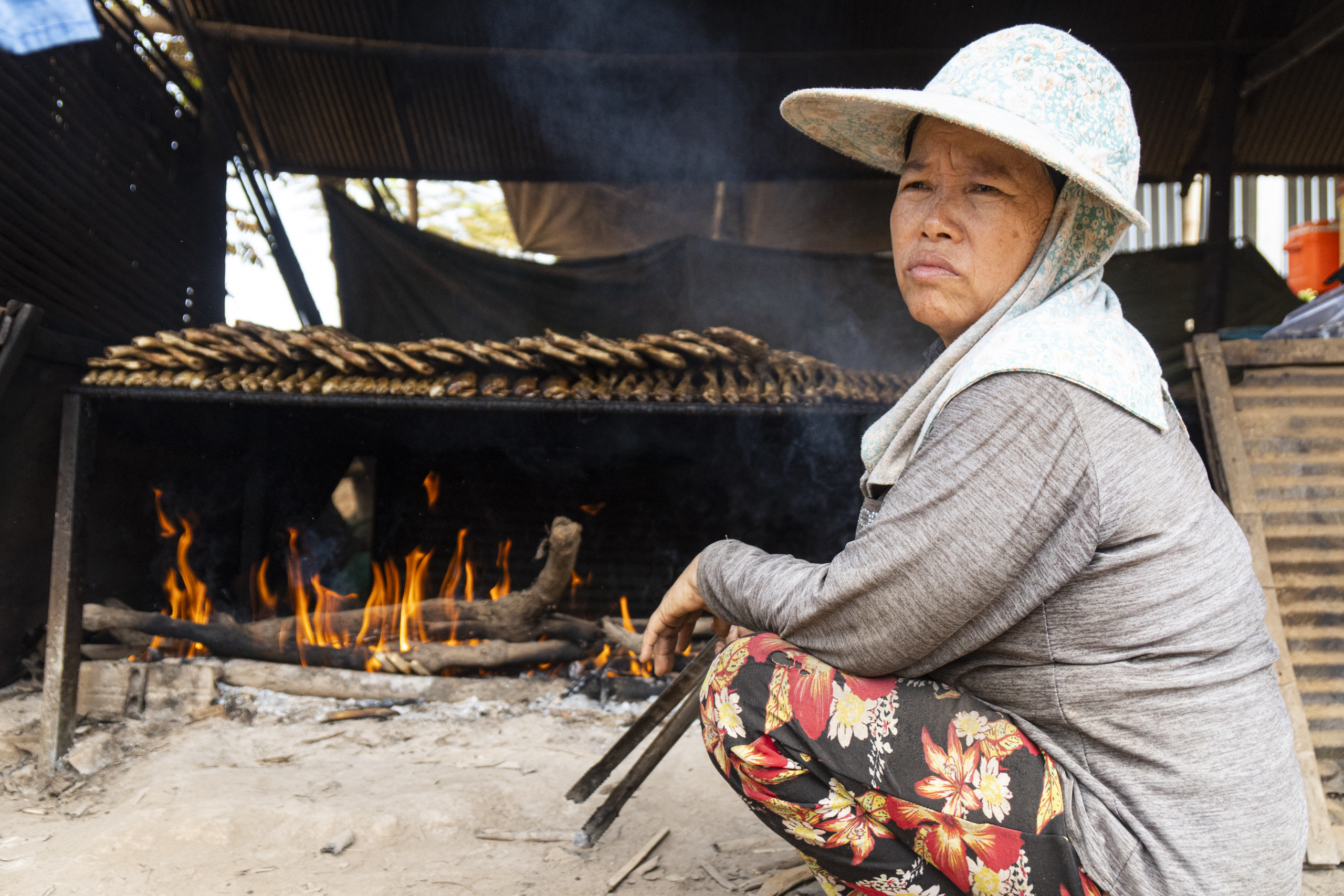

Khuot Kimhong, 52, has been smoking fish since she was 20 years old. Today, she and her father keep up the business to sustain themselves and Kimhong’s three children.
Previously she was able to buy fish locally from other villagers in her community, but since 2019 that supply has been too erratic. She still buys local fish, but not enough to keep her business alive. Now, she has to travel west to the province of Kampong Chhnang to resupply – a six-hour round trip.
“Now, people buy fish from the Tonle Sap,” she says, referring to the largest lake in Southeast Asia. “They don’t get that many fish [here].”
The Tonle Sap, which reaches a surface area as great as 12,000 square kilometres when inundated during the rainy season, is a key fishery of the kingdom. Itself an extension of the Mekong fed by the Tonle Sap River, the lake depends on the seasonal flooding of the mainstream to replenish itself each year. Much as in the smaller Veal Samnab, where the so-called “pulse” of water grows weaker every year, so too does the vitality of the big lake’s fisheries.


Although its decline continues to be fuelled by outside factors, Tonle Sap is recognised by the state as a key resource worthy of protection. But for the many other lakes, ponds and wetlands of local significance dependent on Mekong flooding, there seems to be little else to do but watch them dwindle away.
Looking at his own future, the fisherman Hoeum sees a limited career for himself on the water.
“After I put my stuff away, I’ll have to look for odd jobs,” he says, adding that his uncle has already quit fishing to raise cows instead. “It has become harder and harder to get fish. Some have [already] left the job to be construction workers.”
